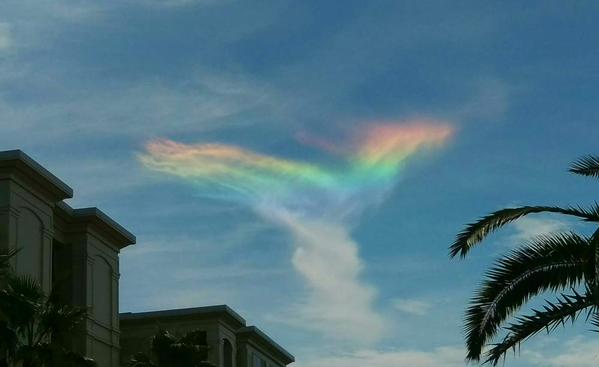Stunning 'Fire Rainbow' Formed by Halo of Ice

A so-called fire rainbow filled the sky with a haze of colors over South Carolina on Sunday (Aug. 16) in a recent photo posted to Twitter.
The alluring photo, snapped by Jackie Hill (though there was some debate about who took the photo after Tiffany B. Jenks first posted it to Twitter and claimed to have taken it) in the city Isle of Palms, shows what looks like a V-shaped rainbow of colors painted in the sky. The image gained worldwide attention, possibly for it's nontraditional take on a rainbow. However, the term fire rainbow — referring to the phenomenon's colorful, flamelike appearance — can be misleading, said J. Marshall Shepherd, the director of the Program in Atmospheric Sciences at the University of Georgia in Athens. This is because the halos of light have nothing to do with fire or rainbows, and form when sunlight hits ice crystals rather than raindrops.
The phenomenon is called a circumhorizon arc. The smoky-looking ice halos appear only when the sun is at least 58 degrees above the horizon, Shepherd said. [Amazing Shots of Storms Light Up Weather Photo Contest]
Circumhorizon arcs form giant halos of color that are parallel to the horizon and can extend nearly a quarter of the way around the sky. From the ground, only fragments of the arc are visible, according to Les Cowley, a retired physicist who maintains a website devoted to atmospheric optics. "They are huge and colorful," Cowley said, even if "you might only see a fragment."
The vivid rainbow colors result when the sunlight hits hexagonal ice crystals, at a particular angle, in wispy cirrus clouds, Cowley said. Only cirrus clouds, which float 20,000 feet (6,096 meters) above the ground, are cold enough for ice crystals to develop.
As you move farther from the equator, the sun spends less time shining at altitudes high enough for cirrus clouds to form, Cowley writes on his website. Circumhorizon arcs are rare in middle to northern Europe but common in the United States, Cowley said.
The best place to see circumhorizon arcs is near the equator at noon in midsummer. "They are a summer sight," Cowley told Live Science in an email.
Sign up for the Live Science daily newsletter now
Get the world’s most fascinating discoveries delivered straight to your inbox.
When sunlight passes through these ice crystals, some of the wavelengths refract, or bend, more than others, resulting in a spread of colors, similar to how a prism works, Marshall told Live Science.
Rainbows, on the other hand, form when sunlight passes through raindrops. When this happens, the light is refracted and spreads into the familiar spectrum of colors.
Elizabeth Goldbaum is on Twitter. Follow Live Science @livescience, Facebook & Google+. Original article on Live Science











